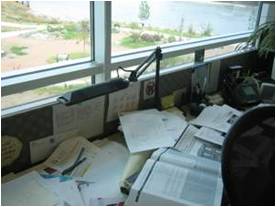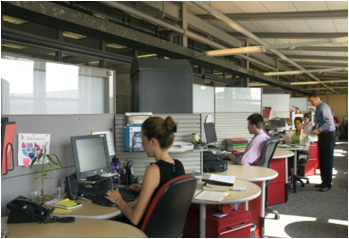Learn
[Skip Sub Navigation]Comfort
Comfortable workers are more likely to be productive and engaged with their work than those who struggle to work in spaces that create barriers and stresses. With ever increasing needs to be mindful of the environment when designing spaces, GSA is developing practices that support both sustainability and worker comfort.
Achieving Both Comfort And Sustainability: Key Practices
- Enable occupant control of ambient conditions. One of the best ways to achieve comfort, health, and energy savings is to enable occupants to adjust ambient conditions in their workspace (e.g., the light levels, ventilation, and temperatures).
- Provide adjustable furnishings and technologies. People come in all sizes, heights, and abilities. Thus their workspace furnishings - from the desk chair to the table height - should be easily adjustable to fit all sizes and abilities.
- Educate occupants. When new controls and furnishings are provided, all occupants should be trained in their proper use. Training is often left to the individual occupant who may not use the controls in the proper way.
- Provide quick response to comfort concerns. Research shows that occupants are more satisfied with conditions overall if their concerns are addressed quickly by facilities personnel.
- Provide feedback to occupants on energy use. The energy reduction goals for federal office buildings may sometimes conflict with comfort. Occupants should be informed of how much energy the building is consuming so that they can adjust their behaviors to help achieve energy goals.
Benefits:
Social:
- Improved employee comfort and satisfaction
- Improved employee health
- Improved work performance
Economic:
- Reduced costs of muscular-skeletal injuries
- Reduced costs of illnesses related to interior quality
Environmental:
- Reduced energy consumption
Case Study Results
Six completed federal workplace projects show that comfort can increase dramatically when the design includes improvements in lighting, air quality, ergonomics and thermal conditions.
Although the designs differed in implementation details, each involved improvements in electric lighting, better access to daylight, materials selected to improve air quality, adjustable task light, and ergonomic furnishings.
Results
| Factor | Percentage Improvement |
|---|---|
| Air Quality | 33% |
| Cleanliness | 33% |
| Furniture Adjustability | 33% |
| Furniture Comfort | 30% |
| Daylight | 23% |
| Views | 23% |
| Temperatures | 18% |
| Amount of Light | 17% |
| Visual Comfort | 17% |
| Noise Levels | 3% |
Project Checklist
- Ergonomic chair is provided for all regularly occupied workstations
- Work tables, desks and files can be easily moved by occupants to a preferred arrangement within workstations
- Adjustable, moveable task lamps with compact fluorescent lamps are provided in all workstations. Under bin light is less useful.
- The computer screen and keyboard are adjustable and can be moved within the workstation
- Individual workstations provide control over ventilation with operable windows, underfloor air distribution vents, or operable ceiling vents
- Windows have adjustable blinds or other sun control devices
- Meeting spaces for 6 or more people have ventilation and temperature controls in the space
- Conference rooms have adjustable light to enable some light to remain on while a projector is in use
- Printers and copiers are centralized and separately ventilated to reduce air quality problems.
- Paper management (such as central filing; increased electronic storage) reduces dust and particulates
- Occupant comfort is regularly assessed through surveys or other means and occupants receive feedback from the survey results
- Facility personnel respond promptly to comfort complaints
- Occupants are made aware of the energy and sustainability goals of their facilities
- Occupants receive feedback about the on going energy performance of the building through the use of a dashboard or other display methods
Source(s):
- "The New Federal Workplace", GSA Public Buildings Service, June 2009, available at http://www.gsa.gov/graphics/pbs/GSA_NEWWORKPLACE.pdf
- "The GSA Hallmarks of the Productive Workplace", U.S. General Services Administration, Rev. 01/06, 1999, available at http://www.gsa.gov/graphics/ogp/HallmarksoftheProductiveWorkplaceMar07.doc
Gallery



Did You Know?
Case Study
Flexibility

Today's workplaces are often in flux. As organizations change direction or develop new services, people also move. Teams form and re-form. People move to new spaces and take on new responsibilities. The spaces themselves are transformed to meet new needs. These changes are much easier to accommodate, with less stress on people and the organization, when the workplace is designed to support flexibility.
Share Your Story
Do you have a story to share? See and share examples of successes and struggles from our user community in Share